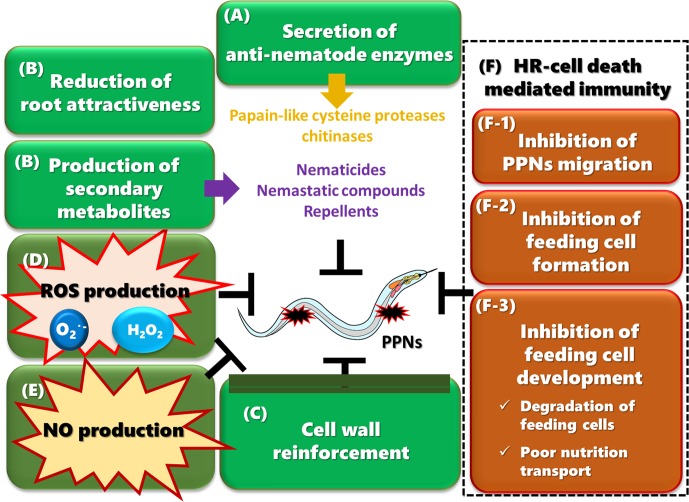Figure 2.
Multiple plant immune responses against PPNs (A) Plants secrete anti-nematode enzymes such as papain-like cysteine proteases (PLCPs) and chitinases into the apoplast to attack PPNs. (B) Resistant plants produce a wide range of secondary metabolites in response to PPN infection. Some metabolites inhibit egg hatching, suppress the motility of migrating PPNs, arrest growth and development, or kill nematodes. Plants may also reduce chemoattraction by secreting less amounts of attractants or more repellents. (C) Plants reinforce their cell walls by accumulating lignin, suberin, and callose, which strengthen the physical barrier to PPNs. (D) PPN infection induces the production of ROS, which may be directly toxic to PPNs. Hydrogen peroxide plays a role in cell wall cross-linking. ROS may also work as a transducing signal to activate immune responses and to control HR-cell death. (E) NO production is induced upon PPN infection and may play a role in JA-mediated defense responses, possibly through the production of protease inhibitor 2. (F) HR-cell death is crucial for limiting PPN movement and completing the life cycle. (F-1) HR-cell death occurs during penetration and migration of PPNs in cortical and epidermal tissues, contributing to inhibition of migration. (F-2) HR-cell death is induced in cells infected by RKNs or CNs, which inhibit the formation of feeding cells. (F-3) HR-cell death is also induced in cells surrounding feeding cells, often resulting in degeneration of feeding cells. Even if some feeding cells survive, the nutrient transport from surrounding tissues to the feeding cells is limited, causing a reduction in the number of eggs, and production of relatively more males. Some resistant plants induce the deterioration of feeding cells without any HR-cell death of surrounding cells.

